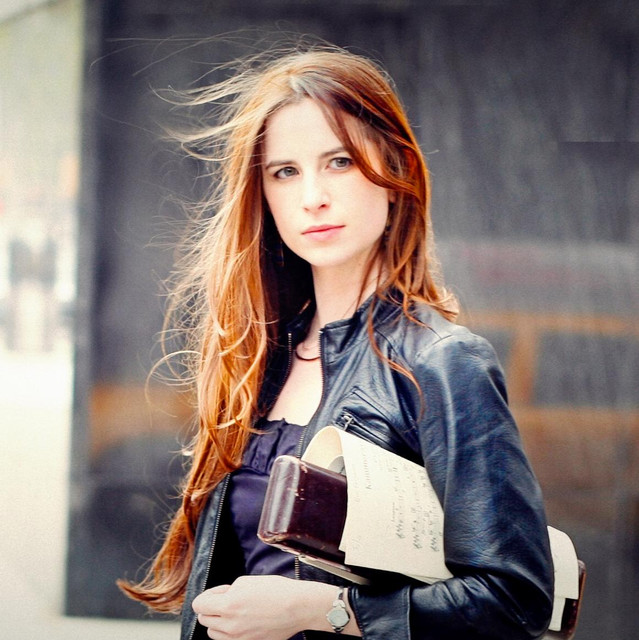Flutist Ferguson, RUCKUS go back to the future with big-band Bach

The first thing one noticed when Emi Ferguson entered Corpus Christi Church Sunday to play Bach flute sonatas was the size of her entourage.
Typically, to perform a Baroque-era flute sonata, you need three players: the flutist, and a harpsichordist and a cellist to make up the “basso continuo,” which plays the bass line and fills in the harmonies.
Those players did indeed enter with Ms. Ferguson. And so did players of the theorbo, Baroque guitar, bassoon, and double bass. As she began performing her arrangement of a Bach keyboard prelude, her six collaborators joined in, con brio, nearly drowning out her gentle-toned wooden flute with their ruckus.
In this program, titled “Fly the Coop” and presented by Music Before 1800, the audience was in fact witnessing a reunion of flutist Ferguson with the daring early-music ensemble RUCKUS, which made an album of Bach sonatas and preludes with her last year of the same title.
The coop in question was the strictures of early-music scholarship, which along with its valuable insights seemed also to produce an ever-lengthening list of no-nos for the performance of Baroque music: no vibrato, no rubato, no anachronisms, etc. Bassoonist and RUCKUS founder Clay Zeller-Townson and his friends (Anthony Albrecht, Baroque cello; Evan Premo, Baroque bass; Paul Holmes Morton and Arash Noori, theorbo, Baroque guitar; and Parker Ramsay, harpsichord, organ, harp) decided to take their clavichords and lutes and go in search of new yes-yeses.
Bach’s music in particular seems endlessly adaptable, not only in arrangements for various instruments but in updates by the likes of Schoenberg, Stravinsky and the Modern Jazz Quartet.
It was, one supposes, just a matter of time before someone thought of projecting contemporary, cross-cultural sounds and rhythms onto the actual instruments of Bach’s day. We do it all the time with the piano, which was designed a century and a half ago for the likes of Franz Liszt, not Elton John.
Bach’s sonata scores, like everyone else’s in that era, left much composing work for the player to do. A top line, and a bass line with some numbers to indicate the harmonies—that’s all there was on the page.
Zeller-Townson and his colleagues took a look at that figured bass, and figured out a new way.
On Sunday, the new way was loud. It was percussive—no actual drums, just a slap-that-bass playing style with stringed instruments. It was syncopated and catchy—a thousand-year-old practice, by the way, not invented by Scott Joplin. It was open to newly-composed counterpoints, or to mash-ups like quoting the “Goldberg” Variations in the middle of a flute sonata.
It didn’t go for the belly laugh, like P.D.Q. Bach. Knowing smiles, however, were definitely encouraged.
And by the way, shed no tears for Emi Ferguson. A versatile artist whose early-music credentials include principal flute of Boston’s Handel and Haydn Society, she more than held her own amid the racket, coaxing her Baroque flute into elegant and sensitive phrasing, brilliant fingerwork, and incisive attack when needed.
She also emceed the proceedings with genial commentary on Bach, his mid-career discovery of the flute as a solo instrument, his changes in composing style over time, and his three surviving sonatas for flute and continuo, which formed the core of Sunday’s program.
The players led off with the acknowledged masterpiece of the three, the Sonata in E minor, BWV 1034, thought to date from 1724, when Bach was composing his great series of church cantatas for Leipzig. The opening Adagio ma non troppo alternated full-throated tutti with lightly accompanied interludes for the flute. A light but brilliant Allegro sent the flute on a dizzy run of nonstop sixteenth notes. A beautifully shaped, eloquent Andante prepared the way for a robust Allegro finale, with flute coloratura topping the ensemble’s eager dance.
As it comes down to us, the Sonata in C major, BWV 1033, appears something of a hybrid, with its sophisticated solo line paired with a rather simple bass, the latter possibly composed as an exercise by Bach’s son Carl Philipp Emanuel, then about age 17. With the door thus opened, Ferguson et al. went all out with this piece, and especially its first two movements, as an exercise in enhancing, updating, and relating it to other music.
Lush, almost Romantic harmonies glowed in the opening Andante. Shouldered out by a new bass line in the second movement, C.P.E.’s student effort found refuge in an upper part. Struck by a resemblance of this music to the sixth “Goldberg” variation, the arrangers segued into the latter, then back to the sonata. Harpsichordist Ramsay didn’t play the “Goldberg” himself, however, since he was busy accompanying on harp. A florid Adagio over a deep-toned ensemble relaxed into two minuets to close the refurbished sonata.
The later Sonata in E major, BWV 1035, composed around 1741, found Bach dabbling in the new “sensitive” and galant styles pioneered by his sons C.P.E. and Johann Christian. Ferguson and RUCKUS updated it still further, especially in the Siciliano third movement, refitting it with a new, grooving bass line and florid, fantastical inner parts.
Interleaved with the larger works—and sometimes even between their movements—were an assortment of keyboard preludes from sources such as The Well-Tempered Clavier and the “Anna Magdalena” notebook, in arrangements that showcased the group’s expressive range, from delicate to raucous. One of the more sensitive ones involved lutenist Morton on banjo.
The concert’s lone encore brought it full circle: a repeat of the G major Prelude with which it began, minus the shock value, plus a new understanding of what this novel concert had been all about.
Music Before 1800 presents the vocal group Blue Heron with string and brass ensemble in Christmas music by Praetorius, Scheidt and Schein, 4 p.m. Dec. 22 in Corpus Christi Church. mb1800.org


